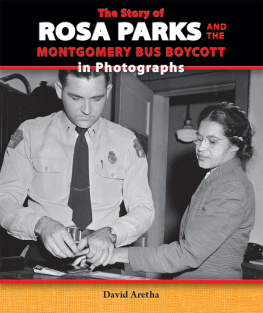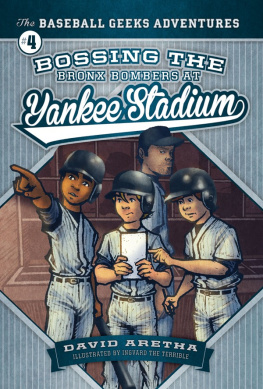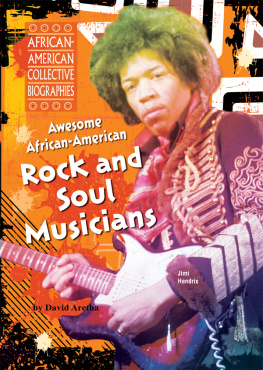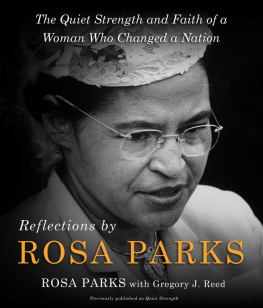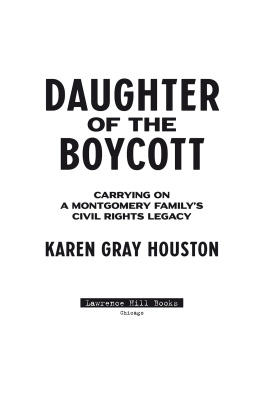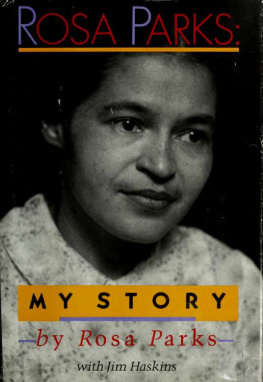The Story of ROSA PARKS AND THE MONTGOMERY BUS BOYCOTT in Photographs
In Montgomery, Alabama, segregation was a way of life for African Americans. Rosa Parks, riding the bus after a long day of work, was tired of it. When the bus driver demanded she leave her seat for a white man, Parks refused. The police arrested her. Parks's courage ignited a boycott of Montgomery's buses, one of the great protests that sparked the Civil Rights Movement. Through dramatic primary source photographs, author David Aretha explores this pivotal moment in American history.
About the Author
David Aretha, editor of the acclaimed Civil Rights Chronicle: The African-American Struggle for Freedom, has written numerous books on the subject for young readers.


Image Credit: Library of Congress Prints and Photographs
African Americans wait at a segregated bus station in Durham, North Carolina.
In 1943, Rosa Parks entered a city bus in Montgomery, the capital of Alabama. As she paid her fare, bus driver James F. Blake told her to leave the bus and reenter it from the rear door. He said this because she was African American. In Montgomery, black citizens could only sit in the back of the buses. The bus driver was in a bad mood that day. As Parks walked toward the rear door, he sped off. Parks had to walk more than five miles to get homein the rain.
Jo Ann Robinson had her own bad experience on a Montgomery bus, as she recalled in her book The Montgomery Bus Boycott and the Women Who Started It. On the Saturday before Christmas in 1949, this African-American English teacher sat in the fifth row. She didnt know that the row was reserved for white passengers. The angry bus driver got up and approached her. He raised his hand as if to smack her and yelled, Get up from there.... Get up from there! She ran out of the bus, sobbing.
Parks and Robinson lived in the segregated South. A segregated society means that the dominant racial group separates and mistreats a less-powerful group. In the South, whites had enslaved and mistreated black people from the 1620s until the U.S. government abolished slavery in 1865. From that point until the 1960s, southern whites continued to pass local and state laws that were unfair to black citizens.
In the South, whites created black codes and then segregation laws to oppress black people, whom they considered inferior. In the South, whites had their own schools, restaurants, movie theaters, churches, and so on. Blacks were allowed only in colored facilitiesblack schools, swimming pools, outhouses, and more. Many streetcars, railway cars, and buses were segregated within. Whites sat in the nicer sections, typically in the front. Black passengers had to sit in the back.
In 1896, the U.S. Supreme Court ruled that separate but equal facilities were acceptable. In the South, facilities were separate but hardly ever equal. White students had decent schools. But black schools were woefully underfunded. Many were drafty one-room shacks. The black teachers earned only a fraction of what white teachers were paid. Most black workers were forced into unskilled jobs and earned low wages. Some still lived on white-owned plantations and picked cotton, like their ancestors had done during slavery.
Southern whites developed various schemes, including violence, to prevent black citizens from voting. White citizens voted for white politicians, who maintained the segregation laws and customs.
As a child in Atlanta, Georgia, Martin Luther King, Jr., experienced segregation in a shoe store. The salesman told his father that he could try on shoes only in the back of the store. Kings father, a pastor, left in a huff.
Recalled Martin, Jr., in his book Stride Toward Freedom: I still remember walking down the street beside him as he muttered, I dont care how long I have to live with this system, I will never accept it. Martin, Jr., wouldnt, either.
By 1955, King, Jr., had become a twenty-six-year-old pastor of a church in Montgomery. Many facilities in Montgomery were still segregated. The segregation practices enforced on the city buses created the greatest discontent in the African-American community.
For many years in this city, African-American bus riders had to do the following at each bus stop: 1) Remain outside until the last white person waiting boarded the bus. 2) Enter and pay their fare. 3) Turn around and step out of the bus. 4) Reenter through the side door Exit. 5) Seat themselves from the rear forward up to (but not in) the fifth white row of seats.
If the five white rows were all filled, new white passengers had the right to sit in the middle rows. This meant that any black passengers sitting there would have to get up and stand or go sit in the back. The bus driver would tell them to leave those seats to make room for the new white passengers. Gussie Nesbitt remembered being stuffed in the back of the bus just like cattle, as Robinson recalled in her book. Black riders felt humiliated.
Robinson headed the local Womens Political Council (WPC). Members of that organization tried to end segregation on the buses, or at least improve the conditions. They informed the mayor that the bus drivers (all of whom were white) harassed black riders. Sometimes, they threw the black passengers change at them. On rainy days, the drivers often didnt let African Americans on the bus. Moreover, bus stops in African-American neighborhoods were few. This meant longer walks for black riders. Back then, buses didnt have air-conditioning. The heat and humidity added to the terrible conditions.
Despite the fact that the bus company depended heavily on African-American riders, segregation continued. More than 20,000 black citizens rode the buses to get to work. However, the bus company hired African Americans only for low-paying jobs, such as janitor or handyman.
By 1955, some lawyers had tried to end segregation laws in the South. According to the U.S. Constitution, the lawyers claimed, such laws were invalid because they deprived African Americans of their basic rights as U.S. citizens. Black attorney Fred Gray and local black activist E. D. Nixon tried to fight Montgomerys bus segregation law in federal (U.S.) court. They hoped that a black citizen would be arrested for violating a bus law so that they could appeal the case in federal court.
In 1955, fifteen-year-old Claudette Colvin and then Mary Louise Smith were arrested in Montgomery for refusing to give up their seats to white passengers. However, Nixon did not appeal the cases. He did not feel Colvin and Smith were sympathetic figures. Colvin was pregnant, and Smiths father was an alcoholic. The black community might not rally to their support. Whites would be critical of the women.
But on December 1, 1955, a woman of fine moral character was arrested on a Montgomery bus for refusing to give her seat to a white man. Her name was Rosa Parks. With Parks, Nixon finally had his case.

Image Credit: AP Images / Horace Cort
In many southern cities, buses were segregated. Whites sat in front, and African Americans had to sit in the back.
On December 1, 1955, a single incident sparked the Montgomery bus boycott. After working all day as a seamstress, forty-two-year-old Rosa Parks sat in the sixth row of a Montgomery bus. When a white man entered the bus, driver James Blake ordered Parks to get out of her seat so that the man could sit there. She refused.

